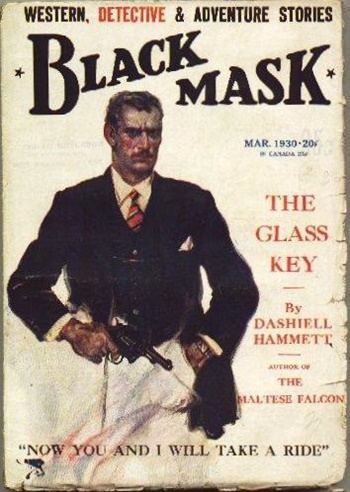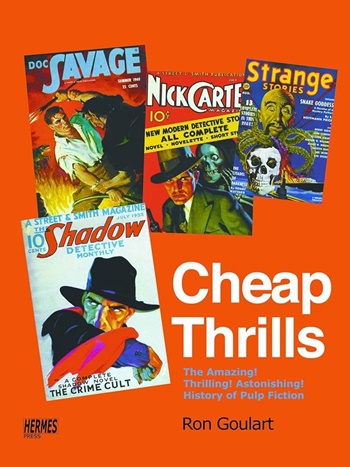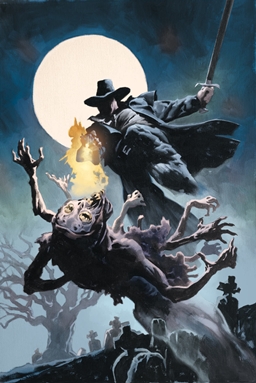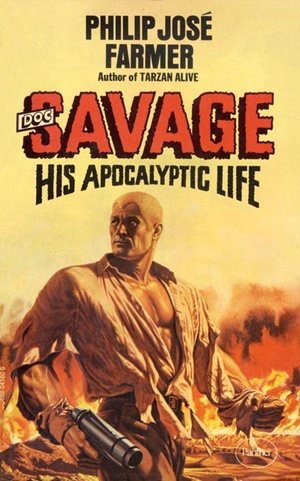A Black (Gat) in the Hand: Will Murray on Dashiell Hammett’s Elusive Glass Key
 Back in June, Will Murray donned his deerstalker and showed that Dashiell Hammett was not the author of “The Diamond Wager.” He’s back again this week with his magnifying glass out and looking into the origin of the title to Hammett’s novel, The Glass Key. Read on! And if you’ve not read The Glass Key (which is also a terrific movie starring Alan Ladd), you’re missing out on one of the best hardboiled novels written. The game is afoot (again)!
Back in June, Will Murray donned his deerstalker and showed that Dashiell Hammett was not the author of “The Diamond Wager.” He’s back again this week with his magnifying glass out and looking into the origin of the title to Hammett’s novel, The Glass Key. Read on! And if you’ve not read The Glass Key (which is also a terrific movie starring Alan Ladd), you’re missing out on one of the best hardboiled novels written. The game is afoot (again)!
Back in the 1980s, I knew a pulp writer named Charles Spain Verral, who was perhaps best known for writing the Bill Barnes, Air Adventurer Magazine lead novels as George L. Eaton. Chuck told me an illuminating story about Dashiell Hammett that was circulating in the New York City literary scene during the 1930s.
Hammett needed an advance from Black Mask magazine, which editor Joe Shaw was willing to give on the basis of a title alone. Hammett came up with “The Glass Key.” And was stuck with it because in those days the magazine cover was printed a month or more in advance of the interior of the magazine, and The Glass Key was to be the cover story of the next scheduled issue. Compounding the problem, the serial was announced by that title in the issue preceding the one where it was cover-featured. Hammett was to write the novel in installments, with the first one appearing in print before he finished the work.
According to Chuck, Hammett began writing the serial, which duly appeared in four consecutive monthly issues, beginning with the March, 1930 issue, but found that he was unable to justify the title in the unfolding story. With each new installment he penned––Hammett was furiously writing on the fly in an effort to make his monthly deadline––the problem became increasingly acute. Finally, he faced the final chapters and desperately needed a solution.
Ultimately, Hammett resorted to a ploy that was probably inevitable under the difficult circumstances. He came up with the idea of a glass key appearing in Janet Henry’s nightmare of being in a house filled with snakes, along with protagonist Ned Beaumont. The glass key functioned as a metaphorical symbol for their salvation.
Hammett scholars and critics have dissected this dream sequence, interpreting it in different if ingenious ways. Whether the author had any of those interpretations in mind cannot ever be known.
According to Hammett biographer Diane Johnson, the last third of The Glass Key was written in a thirty-hour writing marathon in February, 1930––the month the serial’s first installment appeared on the nation’s newsstands.
I built an article around this anecdote for The Armchair Detective, where it appeared in the Summer, 1989 issue as “The Riddle of the Key.” Later, it was reprinted in A Critical Response to Dashiell Hammett, edited by Christopher Metress (Greenwood Press, 1994). But I was never fully satisfied as to its factual basis. The account was plausible enough, but no hint of it had ever appeared in any Hammett biography I ever read. Chuck didn’t know Hammett personally. He could only remember hearing the account during a gathering of writers back in the 1930s, which he attended with his wife, Jean. The New York-based pulp community during the Great Depression was a tight circle, akin to a subculture. Almost everybody knew everybody else. They socialized at parties, as well at meetings of the American Fiction Guild. And of course they talked shop.
But I always wanted verification. Verral’s account of the novel’s origins was received second-hand. Hammett’s letters record a longer genesis, casting at least a shadow of doubt on the anecdote.
According to the Selected Letters of Dashiell Hammett, 1921–1960, edited by Richard Layman and Julie M. Rivett, The Glass Key was written in a sporadic fashion over a seven-month span of time.
Writing to Knopf editor Harry Block on July 14, 1929 from San Francisco, Hammett stated: “I’ve a title I like––The Glass Key––and at least part of a plot to go with it. I’ll probably get going on it next week.”
This doesn’t sound as if the title was coined off the cuff.
Between August and October, Hammett regularly updated his publishing contacts at Knopf, admitting that The Glass Key was coming along slowly, but that he expected to complete it “by the middle of December at the latest.”
Ultimately, writing Herbert Ashbury on February 6, 1930, Hammett related, “The Glass Key, held back thus far by laziness, drunkenness, and illness, promises to get itself finished somehow by the latter part of next week.”
 This supports the report that Hammett had yet to write the concluding chapters after Black Mask had committed to running the serial. But a Summer, 1929 start suggests that Hammett might have had the book’s title already in mind before reaching out to Joe Shaw for an advance––and may well have had a substantial section of the book drafted by that point. Hammett relocated to New York City in October, 1929, and likely conferred with Shaw during or after that time. At that point, he optimistically predicted that he’d have the manuscript completed before the end of 1929.
This supports the report that Hammett had yet to write the concluding chapters after Black Mask had committed to running the serial. But a Summer, 1929 start suggests that Hammett might have had the book’s title already in mind before reaching out to Joe Shaw for an advance––and may well have had a substantial section of the book drafted by that point. Hammett relocated to New York City in October, 1929, and likely conferred with Shaw during or after that time. At that point, he optimistically predicted that he’d have the manuscript completed before the end of 1929.
But that alone is not sufficient evidence to sink the story. Surviving letters suggest that The Glass Key was conceived with hardcover publication in mind. That does not preclude Joe Shaw purchasing First Serial Rights for Black Mask, holding off printing the first installment until Hammett had submitted all but the climactic chapters, when it was reasonably safe to do so. Hammett had been living off Knopf advances during the summer and into the Fall of 1929. Relocating to Manhattan might have put him in the financial squeeze of needing another. But this time, he turned to Shaw, who appeared to be willing to schedule the incomplete serial, despite the risk that the author might miss the critical deadlines. The March, 1930 Black Mask would have been assembled in January at the latest, for an on-sale date of February 12th.
All of this is supposition, of course. I wanted validation.
Well, I finally found it in a letter that Black Mask regular Fred Nebel wrote to Ron Goulart some decades ago and which was printed in full in the 2007 Hermes Press edition of Goulart’s Cheap Thrills. Nebel was a drinking buddy of Hammett’s.
Nebel recalled that Hammett did, in fact, have a nagging problem coming up for an explanation for the ongoing serial’s title.
In the letter dated June 12, 1966, Nebel wrote:
“The only time Hammett ever discussed work–in-progress with me was when he got jammed up on The Glass Key. I think it was being serialized in B. M. and his trouble was the title. He didn’t know how to fit the title in and since several installments had been run, there was no way out, except to make the title fit. I was no help to him. He finally figured it himself. If you recall the dream sequence, that was how he solved it.”
This perfectly matches what Chuck Verral told me. Here is his account, in his own words:
“The incident of the glass key came about when Jeanie and I were with a bunch of detective writers, and probably some Black Mask people, and we were talking about Dashiell Hammett. And we were also talking about, I think, the advances I used to ask from Street and Smith. Orlin [Bill Barnes editor F. Orlin Tremaine] would say, ‘Okay, give me a title.’ And I’d give him a title and the check would be in the next mail. It came out that Hammett was facing the same situation, and he was asked for a title for, I guess, Black Mask. Thinking of a tricky title, he said ‘The Glass Key.’ And then, when he had to write the thing, he couldn’t figure out how to get the glass key in the title into the story. And he had his character have a dream. And of course, when the key went into a lock, it shattered.”
Verral could not clearly recall the name of the person who related that anecdote, but mused that “It may have been Fred Nebel who told me that.”
That completes the circle elegantly. So the legendary backstory to The Glass Key can now be considered confirmed and factually sound.…
Thanks to Rob Preston and John Locke for their kind research assistance.
Prior Posts in A (Black) Gat in the Hand – 2023 Series (12)
 Back Down those Mean Streets in 2023
Back Down those Mean Streets in 2023
Will Murray on Hammett Didn’t Write “The Diamond Wager”
Dashiell Hammett – ZigZags of Treachery
Ten Pulp Things I Think I Think
Evan Lewis on Cleve Adams
T,T, Flynn’s Mike & Trixie (The ‘Lost Intro’)
John Bullard on REH’s Rough and Ready Clowns of the West – Part I (Breckenridge Elkins)
John Bullard on REH’s Rough and Ready Clowns of the West – Part II
William Patrick Murray on Supernatural Westerns, and Crossing Genres
Erle Stanley Gardner’s ‘Getting Away With Murder (And ‘A Black (Gat)’ turns 100!)
James Reasoner on Robert E. Howard’s Trail Towns of the old West
Frank Schildiner on Solomon Kane
Prior posts in A (Black) Gat in the Hand – 2022 Series (16)
Asimov – Sci Fi Meets the Police Procedural
The Adventures of Christopher London
Weird Menace from Robert E. Howard
Spicy Adventures from Robert E. Howard
Thrilling Adventures from Robert E. Howard
Norbert Davis’ “The Gin Monkey”
Tracer Bullet
Shovel’s Painful Predicament
Back Porch Pulp #1
Wally Conger on ‘The Hollywood Troubleshooter Saga’
Arsenic and Old Lace
David Dodge
Glen Cook’s Garrett, PI
John Leslie’s Key West Private Eye
Back Porch Pulp #2
Norbert Davis’ Max Latin
Prior posts in A (Black) Gat in the Hand – 2021 Series (7 )
The Forgotten Black Masker – Norbert Davis
Appaloosa
A (Black) Gat in the Hand is Back!
Black Mask – March, 1932
Three Gun Terry Mack & Carroll John Daly
Bounty Hunters & Bail Bondsmen
Norbert Davis in Black Mask – Volume 1
Prior posts in A (Black) Gat in the Hand – 2020 Series (21)
Hardboiled May on TCM
Some Hardboiled streaming options
Johnny O’Clock (Dick Powell)
Hardboiled June on TCM
Bullets or Ballots (Humphrey Bogart)
Phililp Marlowe – Private Eye (Powers Boothe)
Cool and Lam
All Through the Night (Bogart)
Dick Powell as Yours Truly, Johnny Dollar
Hardboiled July on TCM
YTJD – The Emily Braddock Matter (John Lund)
Richard Diamond – The Betty Moran Case (Dick Powell)
Bold Venture (Bogart & Bacall)
Hardboiled August on TCM
Norbert Davis – ‘Have one on the House’
with Steven H Silver: C.M. Kornbluth’s Pulp
Norbert Davis – ‘Don’t You Cry for Me’
Talking About Philip Marlowe
Steven H Silver Asks you to Name This Movie
Cajun Hardboiled – Dave Robicheaux
More Cool & Lam from Hard Case Crime
A (Black) Gat in the Hand – 2019 Series (15)
 Back Deck Pulp Returns
Back Deck Pulp Returns
A (Black) Gat in the Hand Returns
Will Murray on Doc Savage
Hugh B. Cave’s Peter Kane
Paul Bishop on Lance Spearman
A Man Called Spade
Hard Boiled Holmes
Duane Spurlock on T.T. Flynn
Andrew Salmon on Montreal Noir
Frank Schildiner on The Bad Guys of Pulp
Steve Scott on John D. MacDonald’s ‘Park Falkner’
William Patrick Murray on The Spider
John D. MacDonald & Mickey Spillane
Norbert Davis goes West(ern)
Bill Crider on The Brass Cupcake
A (Black) Gat in the Hand – 2018 Series (32)
George Harmon Coxe
Raoul Whitfield
Some Hard Boiled Anthologies
Frederick Nebel’s Donahue
Thomas Walsh
Black Mask – January, 1935
Norbert Davis’ Ben Shaley
D.L. Champion’s Rex Sackler
Dime Detective – August, 1939
Back Deck Pulp #1
W.T. Ballard’s Bill Lennox
Erle Stanley Gardner’s The Phantom Crook (Ed Jenkins)
Day Keene
Black Mask – October, 1933
Back Deck Pulp #2
Black Mask – Spring, 2017
Erle Stanley Gardner’s ‘The Shrieking Skeleton’
Frank Schildiner’s ‘Max Allen Collins & The Hard Boiled Hero’
A (Black) Gat in the Hand: William Campbell Gault
A (Black) Gat in the Hand: More Cool & Lam From Hard Case Crime
MORE Cool & Lam!!!!
Thomas Parker’s ‘They Shoot Horses, Don’t They?’
Joe Bonadonna’s ‘Hardboiled Film Noir’ (Part One)
Joe Bonadonna’s ‘Hardboiled Film Noir’ (Part Two)
William Patrick Maynard’s ‘The Yellow Peril’
Andrew P Salmon’s ‘Frederick C. Davis’
Rory Gallagher’s ‘Continental Op’
Back Deck Pulp #3
Back Deck Pulp #4
Back Deck Pulp #5
Joe ‘Cap’ Shaw on Writing
Back Deck Pulp #6
The Black Mask Dinner
There are some outstanding names in the ‘New Pulp’ field, but William Patrick Murray’s probably stands above them all. Along with Doc Savage, Will has written Tarzan and The Spider. And he’s quite the Sherlock Holmes writer. Short stories, comic books, radio plays, nonfiction essays and books – Murray has done it all. He created The Unbeatable Squirrel Girl for Marvel Comics, and his collection of essays on Doc Savage, Writings in Bronze, is a must read. I love a good book introduction, and Murray has written some fine ones for Steeger Books. Visit his website Adventures in Bronze.

Bob Byrne’s ‘A (Black) Gat in the Hand’ made its Black Gate debut in 2018 and has returned every summer since, breaking the 100 Post mark in 2023.
He organized Black Gate’s award-nominated ‘Discovering Robert E. Howard’ series, as well as the award-winning ‘Hither Came Conan’ series. Which is now part of THE 5-star reviewed, Definitive Guide to Conan. He also organized 2024’s ‘Talking Tolkien.’
His ‘The Public Life of Sherlock Holmes’ column ran every Monday morning at Black Gate from March, 2014 through March, 2017. And he irregularly posts on Rex Stout’s gargantuan detective in ‘Nero Wolfe’s Brownstone.’ He is a member of the Praed Street Irregulars, founded www.SolarPons.com (the only website dedicated to the ‘Sherlock Holmes of Praed Street’) and blogs about Holmes and other mystery matters at Almost Holmes.
He has contributed stories to The MX Book of New Sherlock Holmes Stories – Parts III, IV, V, VI, XXI, and XXXIII, and XXXVII.
He writes introductions to pulp collections and novels from Steeger Books, and has appeared in several magazines, including Black Mask, Sherlock Holmes Mystery Magazine, The Strand Magazine, and Sherlock Magazine.